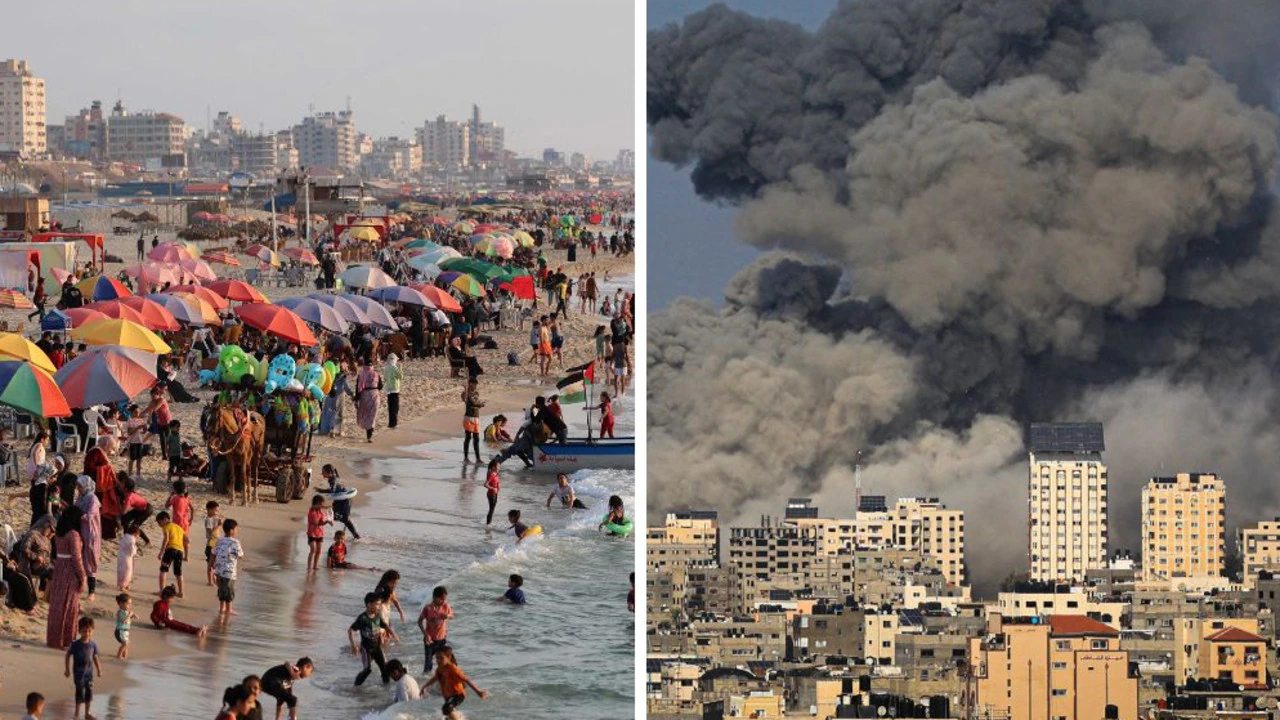By Alex Blair,Ben Graham
Copyright news

What began as a bloody new chapter in the decades-long struggle between Israel and Palestinian factions has unfolded into a humanitarian catastrophe, marked by repeated cycles of ceasefires, collapsed negotiations and renewed offensives.
With tens of thousands of civilians killed and much of Gaza reduced to rubble, the conflict has also reverberated far beyond its borders.
Pictures taken in Gaza City in 2022 show scores of children frolicking at the beach. Now thousands lie dead as a result of the conflict, caused by men behind desks on both sides pursuing ideological crusades.
The unrest has not been contained to Gaza alone.
The fighting has drawn in regional actors, triggered violence along Israel’s northern border with Lebanon, and sparked global condemnation and calls for restraint. Aid agencies warn of famine and disease, while international mediators shuttle between capitals in search of agreements that seldom hold.
The United Nations, major powers, and neighbouring states remain entangled in a web of diplomacy, each wary of escalation but unable to forge a lasting settlement.
The Middle East has sat on a knife-edge for centuries, shaped by cycles of conquest, colonialism, and competing nationalisms. This war is not an aberration but the modern iteration of deep-seated tensions boiling over once more.
Here’s how the current crisis unfolded two years ago on October 7, 2023.
Key events in the conflict
October 7, 2023: Two years ago to the day, at the close of the Jewish festival of Sukkot, Hamas-led militants launched a surprise assault on Israel, making it the deadliest day in the country’s history.
Palestinian fighters breached the Gaza-Israel border, storming southern Israeli communities and a desert music festival with gunfire, rockets and grenades.
The attack resulted in the deaths of 1,219 people on Israeli side, mostly civilians, according to an AFP tally based on official Israeli figures. Militants also abducted 251 hostages into Gaza, of whom 47 remain captive, including 25 the Israeli military says are dead.
Israel immediately declared a “state of war” and retaliated with an intense series of airstrikes. It also imposed a full siege on Gaza by cutting fuel, water, electricity and supplies.
October 8: After 24 hours, Hezbollah began launching rockets, announcing its support of the people of Gaza and that it would stop when a ceasefire was announced.
Mid October, 2023: Israel ordered the evacuation of northern Gaza and launched its first ground incursions.
October 17 2023: A huge explosion took plade at al-Ahli hospital in Gaza. It triggered outcry and competing claims over who was responsible. The death toll is not clear. The Hamas-led Gaza Health Ministry claimed 471 people were killed. US intelligence has since estimated that between 100-300 people were killed.
November 24 to December 1, 2023: There was a pause in fighting – as a four-day ceasefire mediated by Qatar was renewed twice and held from November 24 to December 1.
Hamas agreed to release 50 women and children out of the 237 October 7 captives. Israel agreed to release 150 Palestinian women and children from its prisons.
January 12, 2024: US and British planes began bombing Yemen in response to the Houthis’ attacks on tankers in the Red Sea. While five fighters were reportedly killed, the attacks failed to stop the Houthis’ military activities against vessels in the Red Sea.
May 6, 2024: Israel began a military offensive in and around the city of Rafah. By May 2025, the area within the city limits of Rafah was razed to the ground by the Israeli military.
July 13, 2024: Israeli airstrikes hit the Al-Mawasi area near Khan Yunis in the Gaza Strip. The attack killed at least 90 Palestinians, among them women and children, and injured over 300.
September 27, 2024: Hassan Nasrallah, the secretary-general of Hezbollah, was assassinated in an Israeli airstrike in Beirut. The strike took place while Hezbollah leaders were meeting at a headquarters 18 metres underground beneath residential buildings.
It came after a devastating month for Hezbolla, including the September 17-18 explosions of its handheld communication devices and the September 20 assassination of Ibrahim Aqil, commander of the elite Redwan Force.
November 2024: A ceasefire agreement was signed by Israel, Lebanon, and five mediating countries, including the United States.
January 2025: Israel and Hamas reach a ceasefire and hostage-prisoner exchange agreement.
February 2025: Multiple rounds of hostage-prisoner exchanges take place under the ceasefire.
March 2, 2025: Israel announces blocking of all goods and electricity into Gaza after ceasefire disputes. Israel launches surprise airstrikes across Gaza in the following weeks, ending the ceasefire and killing hundreds in a matter of hours. Ground operations expand as IDF retakes parts of the “Netzarim Corridor”.
April 9, 2025: Shuja‘iyya airstrike: Israeli strike kills over 35 Palestinians and injures 70. Further strikes continue across the strip throughout the month.
July 5, 2025: Israel begins Beit Hanoun offensive and siege in Gaza, Israel declares victory over militants in Beit Hanoun on August 2.
August 20, 2025: Israel opens a new offensive phase in Gaza; dozens reported killed in 24 hours. Famine officially declared in Gaza City governorate and projected to spread further.
September 29, 2025: US President Donald Trump unveils a 20-point peace proposal for the Gaza conflict.
October 6, 2025: Indirect Israel–Hamas talks begin in Sharm el-Sheikh, Egypt, under US, Qatari, and Egyptian mediation. Strikes continue during talks as Gaza authorities claim total death toll surpasses 67,000.